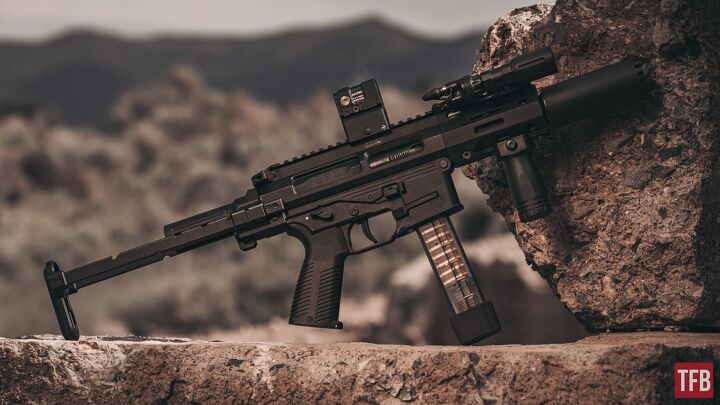The SPC9 PDW SD is B&T’s ultra-compact integrally suppressed addition to the Special Purpose Carbine (SPC) lineup. Using the already popular APC9 lower, the SPC9 adds new hybrid controls and a hydraulic-buffer system. B&T was kind enough to send over their new SPC9 PDW SD for us to review.
B&T USA @ TFB:
- SILENCER SATURDAY #234: Swiss Watch – B&T USA ROTEX-X Carbine Performance
- SILENCER SATURDAY #230: B&T USA RBS Suppressor QDR Mounting System
- B&T USA Ships SPC9 PDW SD Suppressed
- [SHOT 2022] The Quickest Suppressor Ever: B&T Reduced Back Pressure 9mm
TFB Review: B&T SPC9 PDW SD

TFB Review: B&T SPC9 PDW SD
Features
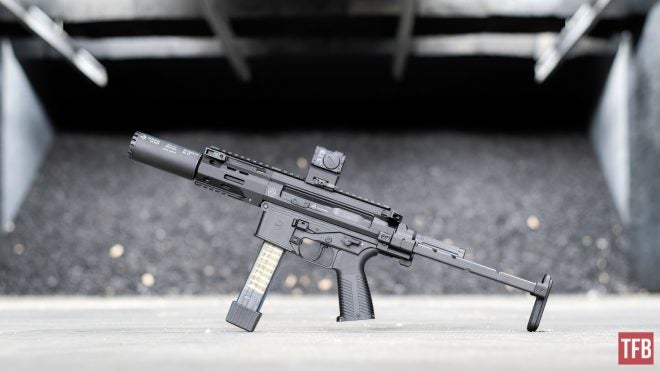
TFB Review: B&T SPC9 PDW SD
The SPC9 PDW SD ships in a hard case with two magazines, cleaning kit, user’s manual, sling, and removable suppressor.
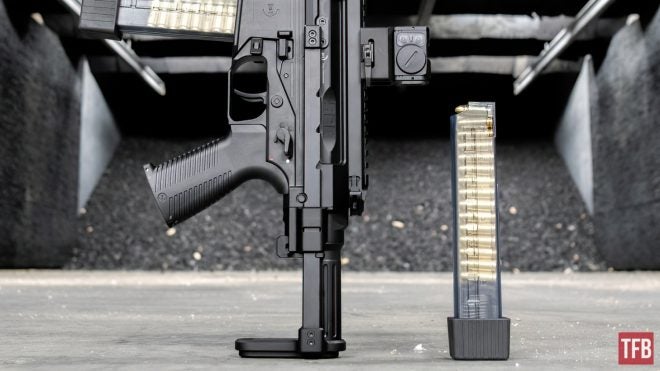
TFB Review: B&T SPC9 PDW SD
The SPC9 uses the same lower as the already popular APC9 family of firearms. While multiple variants will be available that accept other popular pattern pistol magazines, my review copy came with two B&T pattern 30-round magazines with bumpers.
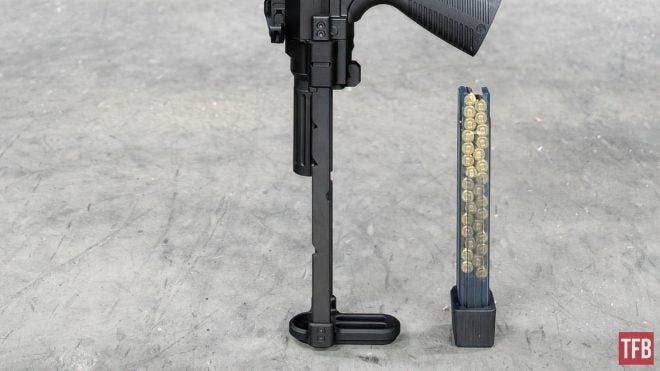
TFB Review: B&T SPC9 PDW SD
The PDW SD comes as either a factory SBR with B&T’s telestock, or as a pistol with a tailhook brace. Both variants have the same MSRP and are three-position adjustable.
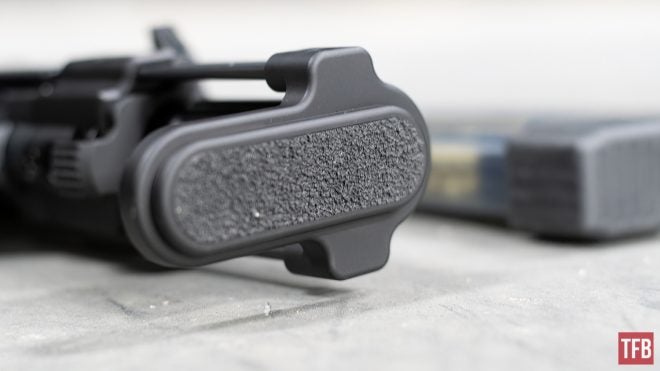
TFB Review: B&T SPC9 PDW SD
On the rear of the telestock is some heavy anti-slip texturing that acts and feels like a 3M anti-slip tape. This does a great job of keeping the stock secure when shouldered but could damage your cashmere dinner jacket if you’re not careful.
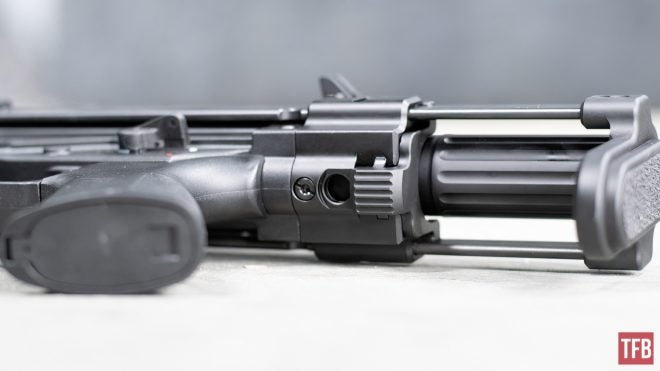
TFB Review: B&T SPC9 PDW SD
To deploy the telestock, simply pull the end rearward past each audible click to adjust the stock to your length of pull. Collapsing the stock is easy. Push the oversized button just rear of the QD sling attachment point at the base and let gravity do the rest. I probably did this a couple hundred times. Of all the telescoping stocks I’ve used, this is my absolute favorite.
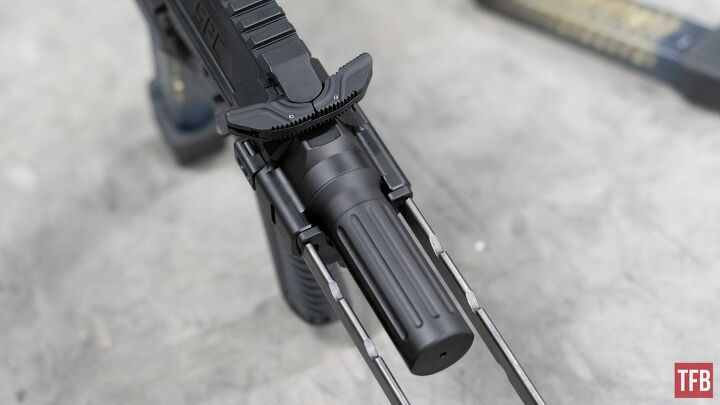
TFB Review: B&T SPC9 PDW SD
The rear of the SPC9 upper houses the new hydraulic buffer system to dampen or lower the recoil impulse. This is where we start to see design features from other pattern firearms incorporated into the SPC.
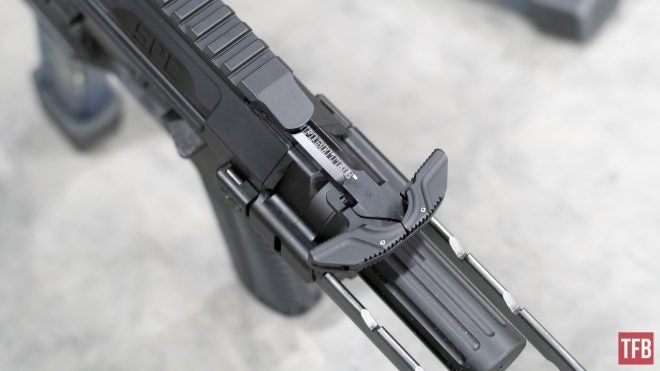
TFB Review: B&T SPC9 PDW SD
There are two ways to charge the bolt on the SPC9. The first is an ambidextrous BCM gunfighter AR-pattern charging handle at the rear of the upper receiver. The nice thing about this design is you can swap this out for any AR-15 charging handle.
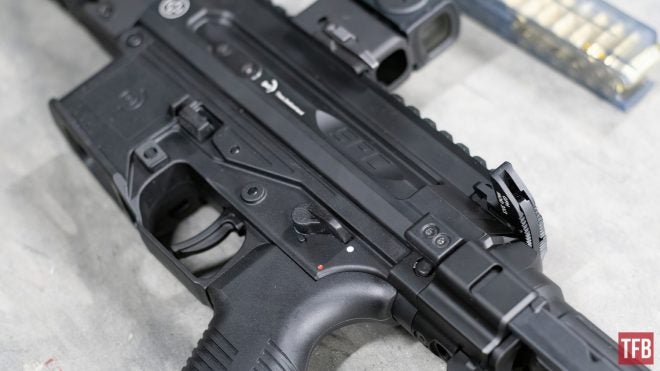
TFB Review: B&T SPC9 PDW SD
This applies to the grip as well. While I liked the B&T factory grip, it’s easily swappable for any AR pattern grip. All your lower receiver controls including safety, mag release, and bolt release are fully ambidextrous.
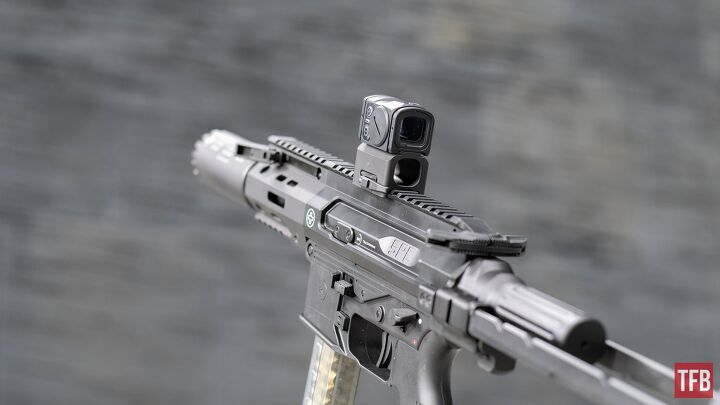
TFB Review: B&T SPC9 PDW SD
Forward on the handguard is a non-reciprocating MP5-esque foldable charging handle. This can also be swapped over to the right-hand side of the firearm to accompany left-handed shooters.
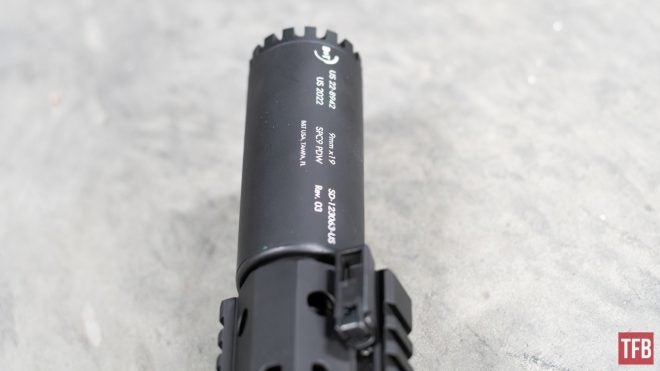
TFB Review: B&T SPC9 PDW SD
Each side of the handguard features two QD sling attachment points for use with a sling. I played around with multiple slings and decided this setup was too short to run a 2-point sling. If you’d like to run a sling, I’d recommend using a single-point sling mounted to the rear QD attachment point.
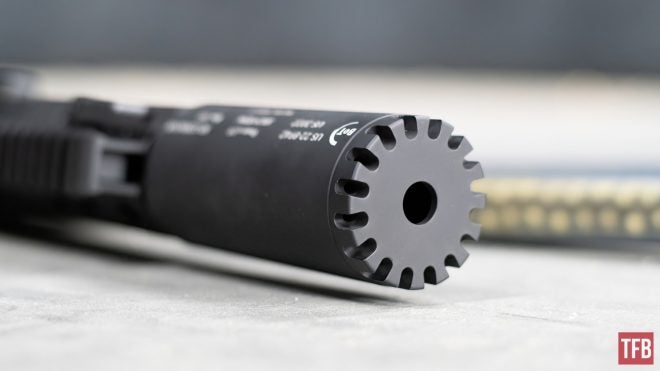
TFB Review: B&T SPC9 PDW SD
The SPC9 PDW SD is a true-to-form SD firearm and features a ported barrel. This renders all of your supersonic rounds subsonic and uses a very short 4-baffle reduced backpressure suppressor (RBS). The suppressor mounts underneath the handguard but can be removed for cleaning. As a true SD with a ported barrel, none of the ammo fired through it should go supersonic. But I had to know for sure, so I headed to the range with a Magnetospeed to find out.
Ammunition Selection
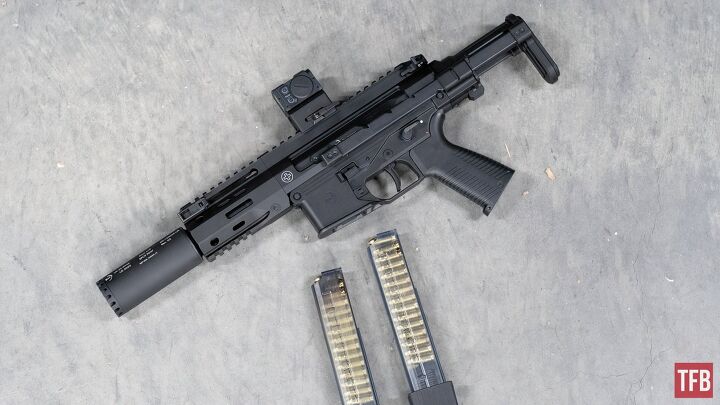
TFB Review: B&T SPC9 PDW SD
____________________________
S&B 115gr RN
Muzzle Energy – 291 ft-lbs
____________________________
Hornady Custom 124gr HP
Avg Muzzle Velocity – 964 fps
Muzzle Energy – 256 ft-lbs
____________________________
StelTH 165gr RN
Avg Muzzle Velocity – 626 fps
Muzzle Energy – 144 ft-lbs
____________________________
Muzzle Energy – 239 ft-lbs
At The Range
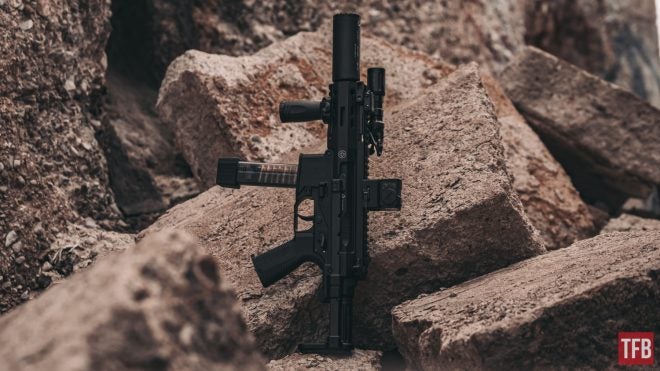
TFB Review: B&T SPC9 PDW SD
At the time of this writing, I’ve had the gun out to the range five times, and I’ve run just over five hundred rounds through it. The gun is small compared to the rest of my SBRs, and it’s noticeably more compact. It’s light enough that packing it around through the desert never felt like a chore. Just grab the magazine or vertical foregrip (VFG) tuck it under your arm and go. It really becomes an afterthought.
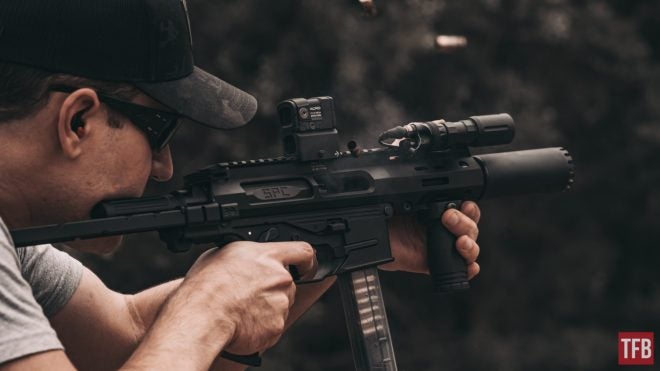
TFB Review: B&T SPC9 PDW SD
Having had a chance to shoot a variety of APCs before this review, I was immediately surprised by the SPC. With the heavy hydraulic buffer in the rear, the recoil impulse is very smooth. I found myself steadily shooting faster and faster throughout the day as a result.
Recoil feels more like a squeeze against your shoulder as the bolt travels all the way to the rear. It would give just enough of a push that the ACRO’s 3.5 MOA dot would rise a little, and then settle back on target just as the next round was going into battery. While this is technically a direct blowback operation, it certainly doesn’t feel like one. So for lack of a better term, I just started calling it buffer-assisted blowback.

TFB Review: B&T SPC9 PDW SD
I wouldn’t say the SPC9 PDW SD is the quietest SD rifle you’ll ever hear, but it’s very quiet given the small size of the suppressor. I wore hearing protection while shooting the rifle (force of habit). Then when I decided to let a few other people shoot it, I removed my hearing protection and stood behind them. Color me impressed. There was no port noise I could detect, and the suppressor has a very nice low tone. Even more impressive was the ejection pattern. At the end of the day, I was left with a neat 2ft wide pile of brass.
Pros and Cons
The SPC9 PWD SD has all the features I’ve ever wanted in a sub-gun, just all crammed into a single gun. It just works every way you want to use it. You can run it like an MP5 and use the forward charging handle to stay behind the optic, rack it from the rear like an AR-15, or just use the bolt release after inserting a fresh mag. Oh and fancy subsonic ammo? No need, everything is subsonic already.
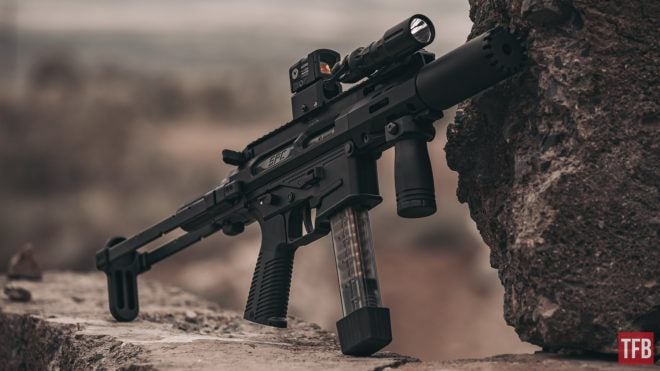
TFB Review: B&T SPC9 PDW SD
Nothing is ever perfect, but as far as complaints go, well these are more like gripes. The heavy safety selector and bolt release from the APC series has carried over into the SPC series. The safety I can work with, but the bolt release requires a very firm push if you’ve just inserted a fully loaded magazine. While I do like double-stack double-feed mags, these are my least favorite with their surprisingly sharp polymer feed lips. I look at the steel APC45 mags and can only hope that someday these will exist in 9mm.
The Verdict
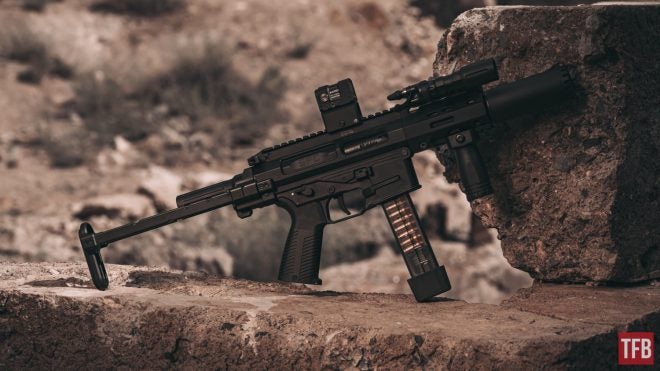
TFB Review: B&T SPC9 PDW SD
The SPC9 PWD SD is available for purchase as either a pistol or as an SBR. Both packages have the same price tag and will set you back $3,248 plus either one or two tax stamps. If that sounds like a lot of money, well that’s because it is. How could it be worth it for that price tag? Well, that part’s simple. While you certainly can tinker with the setup, you don’t need to as B&T has done all the work for you. You just get to buy head to the range and enjoy a gun that’s remarkably accurate and makes everything subsonic. I mean seriously, what more could you want?
Big thank you to B&T for sending this classy little SBR over for review, and a special thank you to IG handle @busterboyd and @jamesondrose for taking these magnificent photos. And as always, thanks for reading!
Product Specs
- Part Numbers: BT-50087 (SBR), SD-123063-US (Silencer)
- Color: Black
- Finish: Type III Hard Coat Anodized
- Material: Polymer / Aluminum
- Caliber: 9mm
- Thread pitch: Integrated
- Barrel Length: 4.5″
- Twist rate: 1:10
- Length:17.8″ (Collapsed) / 23″ (Extended)
- Weight: 5.5lbs
- MSRP: $3,248
We are committed to finding, researching, and recommending the best products. We earn commissions from purchases you make using the retail links in our product reviews. Learn more about how this works.
 Your Privacy Choices
Your Privacy Choices
